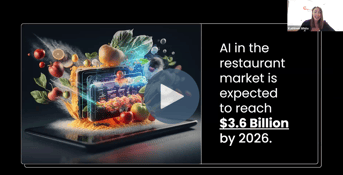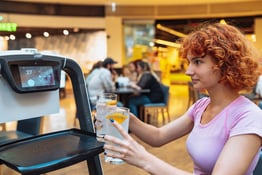For obvious reasons, the pandemic and experiential dining didn’t mix too well. But now, after several years of restrictions, people are not only eager to get out of their homes, but they’re thirsty for new experiences, and they’re reaching for restaurants that can offer more than just food.
In a report from Yelp, searches between 2021 and 2022 for “underwater restaurants” went up by 263% and “dinner theater” searches went up by 109%. Yelp also reported an explosion of new experiential restaurant concept openings, with themed cafe openings up by 75% and supper club openings up by 200%. This year, too, has been the year of pickleball-meets-dining, with places nationwide joining America's favorite new sport with culinary classics, like fried chicken sandwiches. Meanwhile, in Los Angeles, you’ll find a new restaurant themed entirely around Super Mario Brothers, and in Austin, a restaurant specifically designed around role-playing games. And the Topgolfs just keep coming, with number 85 opening last December. Need we continue?
Experiential dining concepts aren’t new. One of the most famous, Chuck E. Cheese, first opened back in the 1970s. Post-pandemic, however, the idea has re-emerged as a burgeoning trend. And if you want to draw in new diners – especially younger audiences ravenous for TikTok and Instagram – it might not be a bad idea to consider how you can tap into the trend at your own restaurant.
Bear in mind, experiential dining doesn’t mean you have to add cats to your cafe…or a pickleball court to your patio. There are plenty of more nuanced ways to incorporate elements that make an experience more engaging.
Below, we break down exactly what “experiential dining” encompasses, plus share a few ideas any restaurant can implement without transforming their entire concept. Use it as inspiration to find strategies that match your own brand and audience.
What is experiential dining?
Experiential dining turns eating out into a multi-sensory experience, designed to create memorable experiences through transporting guests out of their day-to-day life. Elements of an experiential dining experience can include everything from music to decorations to live performances to unique location choices to unexpected food presentations to activities, like games and sports. Sometimes the food is secondary to the entertainment, like at a barcade that focuses primarily on arcade games and somewhat on housemade snacks. Other times, the food’s the star of the show, like when the pasta’s served tableside out of a hollowed cheese wheel or when an Old Fashioned comes with a flamed orange peel.
“The primary goal is to create an experience that guests remember and ideally recommend to their friends,” says Daniel Bendas, managing partner at Synergy Restaurant Consultants, a company that helps restaurants with concept innovation. “When you create these moments, not only are you creating an experience for the individual or party, but you’re often creating buzz that ends up online, which then gets your name in front of a bunch of other people.”
Typically, it all starts with your lighting and music. Right from your exterior lighting, you can give a nod to what lays ahead, and as soon as a guest steps foot inside, the general lighting, table lighting, and how you light the bar all play a role in the ambience you create. The music – both in terms of volume and audio selection – further sets the mood.
“Music in restaurants is critical,” says Bendas. “Invest in great quality and great distribution of the sound, and then curate a really good playlist based on your brand, time of day, and the type of experience you want to convey.”
14 ideas to make your restaurant experience more engaging
Unless you’re planning a fully themed restaurant, more often than not, experiential dining is about taking an already proven concept and giving it your own fresh spin.
“You don’t have to be an experiential brand to create an interactive experience, but you have to stay true to your brand and back up whatever you do with great food and great service,” says Bendas. “Success also comes from building a calendar and really promoting these experiences because that’s going to get people talking.”
Below are a few ideas to spark inspiration, with some more creative and others serving as long-successful ways to engage diners.
1. Throw themed food events: Whether it’s a mocktail pairing dinner, a bourbon tasting night, or a Sunday supper, themed events give guests an added reason to visit, even if they dined at your restaurant only days ago. You can also design specials or limited menus to play off of holidays, and if there isn’t a major one on the horizon, there’s a whole list of national food holidays to test your creativity.
2. Host weekly entertainment: Adding weekly entertainment is a timeless way to transform a standard dining experience into a memorable night out. It also helps to draw bigger crowds and turn first-time guests into repeat visitors. From weekly trivia to jazz acts to drag shows to karaoke nights, the options range wide and far. Choose ones that fit your brand.
3. Build in tableside “eater-tainment” to the menu: Plating or finishing a dish tableside adds an element of excitement and intrigue. This can include everything from filleting a fish, assembling guacamole, flaming a baked Alaska, burning wood over a cocktail, or using dry ice to add a smoky visual appeal to a dish. Eater-tainment requires planning and time on behalf of your staff, but this kind of dinner theater can easily become the detail that guests share with their friends, leading to free restaurant promotion.
4. Designate a special table or room for celebratory or romantic bookings: If you’ve got the space, consider marketing an area that can be booked specifically for special occasions. Maybe it’s an entire private room or a table you can enclose with drapes. You can charge more for the booking and offer to dress it up with elements like rose petals, candles, or other romantic details. This encourages people to celebrate special moments of their life with you, which helps forever associate those memories with your restaurant.
5. Provide games: You don’t need to be a Topgolf or Bowlero to provide games. Add a stack of board games by your bar or set up a bean bag toss on your patio, and invite people to stay for that extra drink. Games bring people together, and may encourage friends and families to gather at your restaurant as opposed to the one next door.
6. Let robots help serve the food: While automation is exploding in the restaurant industry, robots themselves are still considered a novelty, making them a natural marketing tool for any restaurant that deploys them. Guests are curious to see how restaurant robotics work, and you don’t have to be a fully automated restaurant, like Mezli or Spyce, to build the intrigue. In fact, a far more applicable tool for existing sit-down operations is the robo-waiter, which helps waitstaff carry meals to guests. Flash your robo-waiter in marketing campaigns, and you’re likely to attract new customers through your doors. At least a few of those customers are bound to post videos to social media, too, adding to your own marketing efforts.
7. Add a record player: Many people love a bar with a jukebox. But a restaurant with a vinyl jukebox, like New York City’s Tokyo Record Bar, is destined to get some buzz. You could also consider investing in a standard record player, and have nights where you invite patrons to BYOVinyl. While it’s a small element of novelty, it’s one that can make you stand out, especially among music lovers.
8. Consider a photo booth. Plain and simple, photo booths are fun, and they allow your guests to save memories of date nights, friend nights, and beyond. A photobooth can also keep guests occupied when wait times are long, and it can become an extra revenue stream. Plus, the photos naturally serve as a marketing opportunity when you print your branding and social media handles on the bottom of each one.
9. Partner with other local businesses: Teaming up with local businesses for special events helps both parties widen their audience by pooling people from both customer bases. You could collaborate with a local brewery for a beer pairing night, team up with the neighborhood plant shop for a succulent giveaway, or even partner with another restaurant to create a joint menu special.
10. Add self-serve alcohol: Self-serve beer and wine tap technology is on the rise. While there are an array of potential operational benefits, for the customer, it creates a naturally interactive experience, allowing people to sample different drinks of their choice and pour on their own time. For your indecisive drinkers, that’s certainly a draw.
11. Invite animals: Dog-owners often seek out spots that allow them to bring their pups. While you don’t have to keep your doors or patio open to animals everyday, hosting once-a-month events can draw in animal lovers – both ones that own pets and not. Consider also teaming up with a local rescue center. Most welcome the opportunity to show off animals they have up for adoption, and many guests love pairing a beer with a puppy cuddle sesh.
12. Serve dinner and a movie: Movie nights allow you to entice date-night goers and those simply looking for a fun outing. Take advantage of outdoor seating areas and use the exterior walls to cast a projector. To make up for the lack of table turns, serve a fixed menu and take advantage of one of your slower nights to host. For some restaurants, using a projector inside to cast silent films can also create a certain ambience and element of experiential dining.
13. Add QR codes to the menu and the plate: For Troy Bowen, co-owner of Denver wine bar and restaurant Noble Riot, the greatest appeal of QR codes is that they enable restaurants to educate the guest beyond what fits on a menu. “We can introduce podcasts or videos we did with certain winemakers,” says Bowen. Whether or not you’re using QR code menus, you can still take advantage of the technology by placing a QR code on your menu and linking guests to an interactive experience. One restaurant, Boston’s Taranta, has even used squid ink to put QR codes onto customers’ plates. After scanning, diners are directed to a webpage about the dish's ingredients, how it's made, and videos that provide further background.
14. Turn off the lights: This won’t be for everyone, but if you’ve got a bit of an adventurous spirit and are willing to mix things up, consider planning an event series where you serve dinner in the dark. The idea is that by taking away the sense of sight, you enhance the remaining senses, like taste and smell. For inspiration, look to restaurants like New York City’s Abigail’s Kitchen, which uses blindfolds, or London’s Dans le Noir, which blacks out the entire dining room.





